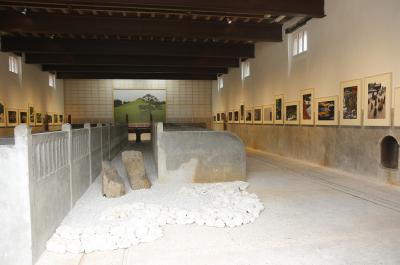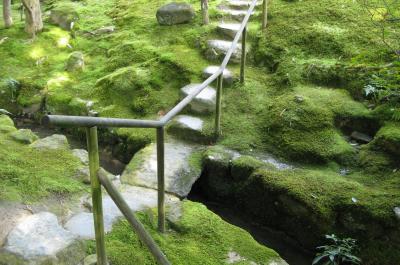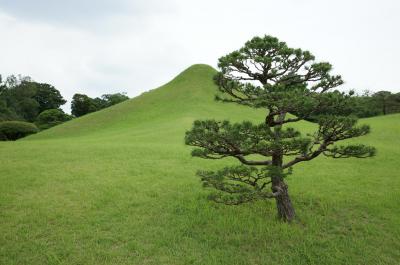Claude Lefèvre spent a great deal of time producing a wide array of photographic projects before coming across Japan. The films by Ozu, Naruse, Uchida, Kurozawa and many other directors opened his eyes to the Japanese culture, at the very time he had begun to get to grips with photography in the 1970s. From then on, their influences on his work were dominant: the strict compositions, the light of Japanese home interiors, the aesthetically composed shots and sequences and understated décors. It is to Japanese culture, cinema and photography in particular that Lefèvre owes a demand for aesthetism that has never left him throughout his photographic career, spanning more than four decades. And it is still what drives him in this work, four years in the making, on the 200 or so most beautiful Japanese gardens, “places of landscape beauty” as the Japanese Ministry of Culture calls them. This work is above all that of an artist, an artistic photographer, even if his approach might sometimes resemble more an anthropological study on the history of gardens – which could be something the photographer takes up in the future. This exhibition therefore endeavours to recreate a history of beauty, a history of the beauty of Japanese gardens, an age-old beauty of the art of staging the beauty of the natural world, of the most remarkable Japanese landscapes, and even of China, with landscapes of cosmogony and beliefs whether these be Shintoist or Buddhist.
“
The films by Ozu, Naruse, Uchida, Kurozawa and many other directors opened my eyes to Japanese culture at the very time I had begun to get to grips with photography in the 1970s. From then on, their influences on my work were dominant – the strict compositions, the light of Japanese home interiors, the aesthetically composed shots and sequences and understated décors. Yes, it is to Japanese culture, cinema and photography in particular that I owe a demand for aestheticism that has never left me throughout my photographic career spanning more than four decades.
This is still what drives me in this work, four years in the making, on the 200 or so most beautiful Japanese gardens, “places of landscape beauty” as the Japanese Ministry of Culture calls them.
The encounter with Japan, in the field, was a long time coming – I had to spend a lot of time and carry out a lot of photo projects that, before coming across Japan, took me on humanitarian wanderings among the peoples of Africa, Mali, Ethiopia, Somalia, Morocco, America, Mexico, Guatemala, Honduras, Peru, Panama, Chile, Bolivia, Patagonia, the Amazonian Amerindians, India, South-East Asia, China for a long time, Vietnam, Cambodia, Indonesia and many other populations with whom I crossed paths in these confines of the world.
The encounter with the gardens of Japan is essentially nothing more than a stage in this thirst to discover other places, due to an insatiable curiosity; as Boris Vian once said, I would not like to snuff it before ……………..
What drives you to travel relentlessly to the other side of the world? a journalist once asked a great traveller, and the latter replied: what interests me is what there is behind.
I wanted to know what was behind this Japan of my culture, meditate before the mysteries of Zen gardens, I wanted to find out what was behind these city names that so captured my imagination, I wanted to discover Japan – the one nestling behind all that.
What spoke to me very quickly in my first confrontations with the gardens of Japan was that I immediately found what had influenced me in my photographic work in the encounter with Japanese photography and cinema, I found myself in the same refinement of space, the same aesthetic rigour, the same staging in space of these objects, stone, rock, bridge, island, lantern, water or its absence implied in these glittering cascades of stones, the mountain, the vegetation so coded, so controlled and yet so light, these sophisticated metaphors so pregnant with meaning and so expressionless that are the Zen gardens of temples I usually chanced upon through the overhang, sort of verandas, houses or temples, almost mystical combinations of right angles and natural forms, the art of seeing gardens in Japan, the very spot where contemplation and even meditation occurs, and this is a completely photographic vision of space – the garden exhibiting itself in this rectangular frame, the precursor of the photo frame.
This is how I felt upon first stumbling across this beauty, this mystery of why this works, how this whole arrangement where nothing is placed haphazardly – which calls upon an age-old art of dressing stones, where the direction the garden faces usually depends on the demands of Chinese geomancy and where Man’s hand is omnipresent – instills such an impression of peace and quiet, of beauty, silence and immanence in me.
I found here not only my photographic subject, which necessarily required recreating this beauty as faithfully as possible, but also, even more ambitious, trying to answer this question of why this works; I have still not managed to find an answer – but is this really so important?
What matters is that it is.
The Japanese Ministry of Culture drew up a list of around 200 names of remarkable gardens located all over Japan, but with many of them naturally to be found in the regions of Nara and Kyoto – the historic capitals of Japan that they are. It has therefore been a pleasure to take this list as my main theme – even if I do not intend to make a photographic inventory of these 200 gardens, especially because some gardens have only been included in this list for a historical link or due to their age, and have no aesthetic merits at all, some gardens are being restored, others are open for one week a year and lastly some gardens that I have discovered during my research – sometimes quite exceptional – do not feature on this list.
This exhibition is therefore the fruit of a photographic journey through more than a hundred gardens from Hokkaido to the extreme tropical islands of Okinawa, taking in along the way virtually all of the prefectures from Aomori to Kagoshima. Some of these gardens were easy to find, while others were so secluded and had been so little heard of that they required a great deal of research (which of course in no way reflected their beauty, which was often quite exquisite).
This work is above all that of an artist, an artistic photographer, even if my approach might sometimes resemble more an anthropological study on the history of gardens – which could be something to take up in the future.
This is therefore a history of beauty, a history of the beauty of Japanese gardens, an age-old beauty of the art of staging – in an often restricted space – the beauty of the natural world, of the most remarkable Japanese landscapes, and even of China, with landscapes of cosmogony and beliefs whether these be Shintoist or Buddhist.
It is this beauty that this exhibition tries to recreate.” Claude Lefèvre
Biographical notes
Claude LEFÈVRE
FRANCE
Claude Lefèvre’s photographic adventure began back in 1966 when he started working for the newspaper France Soir. His first exhibition was held in 1972 at the Musée des Arts Décoratifs. From then on, and even before discovering Japan, he led a life of humanitarian wandering among the peoples of Africa (Mali, Ethiopia, Somalia, Morocco), America (Mexico, Guatemala, Honduras, Peru, Panama, Chile, Bolivia, Patagonia, the Amazonian Amerindians), India, South-East Asia (China for a long time, Vietnam, Cambodia, Indonesia) and many other populations with whom he crossed paths in these confines of the world and which would all be exhibition subjects for the photographer.
Since 2009, Lefèvre has been working passionately on the 200 gardens listed as “places of landscape beauty” by the Japanese Ministry of Culture.




